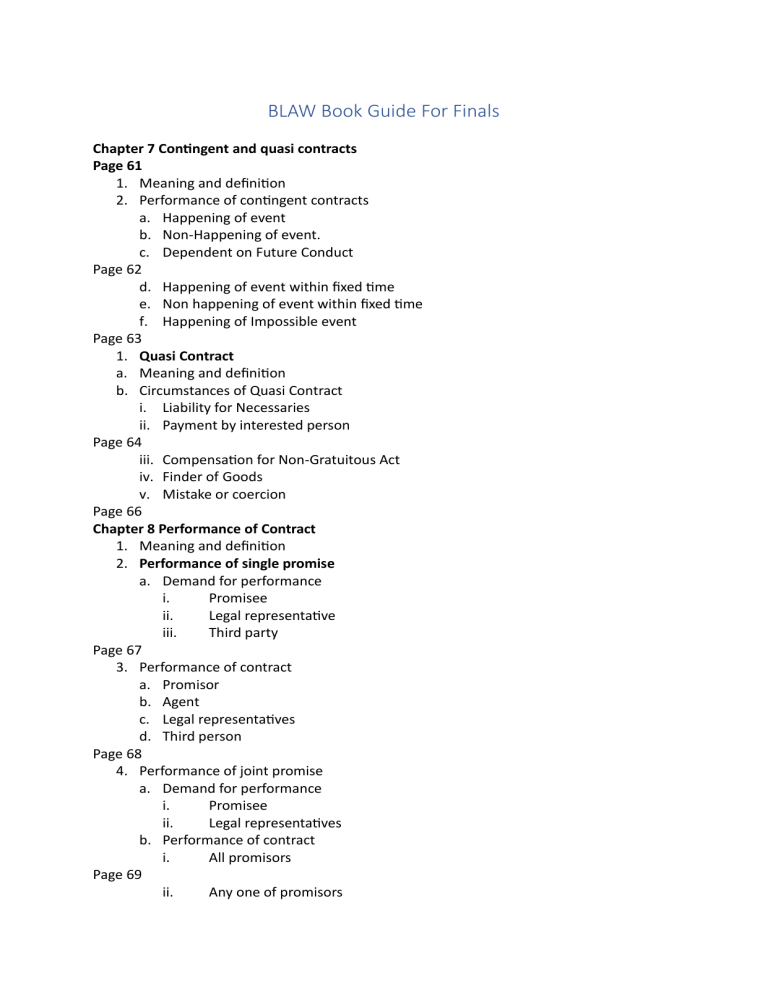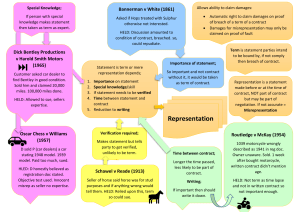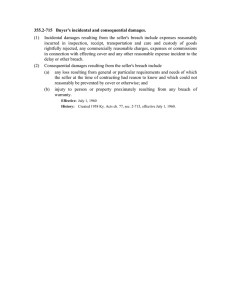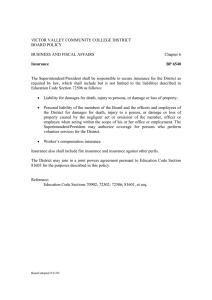
BLAW Book Guide For Finals Chapter 7 Contingent and quasi contracts Page 61 1. Meaning and definition 2. Performance of contingent contracts a. Happening of event b. Non-Happening of event. c. Dependent on Future Conduct Page 62 d. Happening of event within fixed time e. Non happening of event within fixed time f. Happening of Impossible event Page 63 1. Quasi Contract a. Meaning and definition b. Circumstances of Quasi Contract i. Liability for Necessaries ii. Payment by interested person Page 64 iii. Compensation for Non-Gratuitous Act iv. Finder of Goods v. Mistake or coercion Page 66 Chapter 8 Performance of Contract 1. Meaning and definition 2. Performance of single promise a. Demand for performance i. Promisee ii. Legal representative iii. Third party Page 67 3. Performance of contract a. Promisor b. Agent c. Legal representatives d. Third person Page 68 4. Performance of joint promise a. Demand for performance i. Promisee ii. Legal representatives b. Performance of contract i. All promisors Page 69 ii. Any one of promisors iii. Demand for contribution iv. Default in contribution v. Release of promisor c. Assignment of contract i. Act of parties A. Contractual liabilities B. Contractual rights Page 70 ii. Operation of Law A. Death B. Insolvency 5. Reciprocal Promise a. Simultaneous performance Page 71 b. Order of Performance c. Prevention of performance d. Conditional Performance e. Legal and illegal promises f. Alternative promise Page 72 6. Time and place of performance a. Reasonable time b. Specified Date c. Proper Place d. Reasonable place Page 73 e. Prescribed by promise 7. Time is of the essence contract a. Essence of contract b. Not essence of contract c. Delayed Performance 8. Appropriation of Payment Page 74 a. Appropriation by Debtor b. Appropriation by creditor c. Appropriation by Law 9. Contract need not to be performed a. Termination by Agreement b. Remission by promise c. Voidable contract d. Refusal to accept performance Page 76 Chapter 9: Discharge of Contract Meaning 1. Modes of Discharge of Contract a. Actual Performance b. Offer to perform 2. Discharge by Agreement a. Novation Page 77 b. Alteration c. Rescission d. Remission e. Waiver Page 78 3. Discharge by subsequent impossibility a. Destruction of subject matter b. Change in circumstances. c. Death or personal incapacity Page 79 d. Change of law e. Declaration war 4. Discharge by lapse of time 5. Discharge by Operation of Law a. Insolvency Page 80 b. Merger c. Material Alteration 6. Discharge by Breach of contract a. Actual Breach b. Anticipatory breach Effects of Anticipatory Breach Page 82 Chapter 10: Breach of contract 1. Meaning 2. Suit for rescission 3. Suit for Damages a. Ordinary Damages b. Special Damages Page 83 c. Exemplary Damages d. Liquidated Damages e. Nominal Damages Page 84 4. Suit upon Quantum Meruit 5. Suit for specific performance 6. Suit for injunction Page 86 Chapter 11 INDEMNITY AND GUARANTEE 1. MEANING and definition 2. Essentials a. Special contract b. Indemnity by promisor Page 87 c. Reason for loss 3. Rights of indemnity holder a. Recovery of damages b. Recovery of expenses c. Recovery of amount 4. Rights of indemnifier Contract of Guarantee 1. Meaning and definition 2. Essentials Page 88 a. Tripartite contract b. Consideration c. Misrepresentation d. Concealment e. Primary liability Page 89 f. Oral or written g. Capacity of parties Difference between Indemnity and Guarantee Page 90 3. Kinds of Guarantee a. Specific Guarantee b. Continuing Guarantee 4. Rights of surety a. Against Creditor i. Securities ii. Counter claim Page 91 b. Against principal Debtor iii. Subrogation iv. Indemnity v. Against Co-sureties Page 92 5. Discharge of Surety a. Notice of revocation b. Death of surety c. Change in terms of contract d. Discharge of principal debtor Page 93 e. Arrangement f. Creditors act or omission g. Loss of security h. Invalidation of contract i. jsjs Page 95 Chapter 12 Bailment and Pledge Contract of Bailment 1. Mean and definition of bailment 2. Essentials a. Contract b. Specific Performance c. Change of Possession Page 96 d. Return of Goods 3. Kinds of Bailment a. Benefit A. Benefit of Bailor B. Benefit of Bailee C. Benefit of Bailor and Bailee Page 97 b. Reward A. Gratuitous Bailment B. Non Gratuitous Bailment 4. Duties of Bailor a. Disclosure of Faults b. Payment of Expenses Page 98 c. Compensation on termination d. Compensation for defective title e. Recovery of goods 5. Rights of Bailor a. Recovery of damages b. Termination of bailment c. Unauthorized use Page 99 d. Mixture of goods e. Demand of goods f. Demand of increase g. Suit against third party Page 100 6. Duties of Bailor a. Reasonable care b. Unauthorized use c. Mixing of goods Page 101 d. Return of goods e. Return of increase 7. Rights of Bailee a. Claim of damages b. Recovery of expenses c. Right of indemnity Page 102 d. Recovery of loss e. Delivery of goods f. Right of lien g. Suit against third person 8. Termination of bailment Page 103 a. Expiry of time b. Accomplishment of purpose c. Unauthorized use d. On death e. Termination by bailor f. Destruction of subject matter Page 104 9. Finder of lost goods a. Duties of finder A. Find owner B. Reasonable care C. Unauthorized use D. Mixture of goods b. Rights of finder A. Right to retain B. Right of lien C. Suit against third person Page 105 D. Suit for reward E. Right of sale Pledge or Pawn 1. Meaning and definition 2. Essentials of pledge a. Movable goods b. Limited interest c. Transfer of possession Page 106 3. Rights of pledge a. Right to retain b. Particular debt c. Recovery of expenses d. Sue and sell 4. Duties of Pledgee Page 107 5. Rights of pledgor a. Redeem the goods b. Recovery of damages c. Claim of increase 6. Duties of pledgor a. Payment of expenses b. Payment of debt Difference between pledge and bailment Hypothecation Mortgage Page 109 Chapter 13 Contract of Agency 1. Meaning and definition 2. Essentials of agency a. Agreement b. Competent to contract c. Consideration Page 110 3. Kinds of Agents a. General Agent b. Special agent c. Universal Agent d. Mercantile Agent e. Comission Agent f. Del Credere Agent g. Broker h. Auctioneer i. Indenter j. Banker Page 111 k. Advocate 4. Creation of Agency a. Express Agency b. Implied Agency A. Agency by Estoppel B. Agency by Holding out Page 112 C. Agency by necessity D. Agency by Ratification E. Agency by Operation of law Page 113 5. Duties of Agent a. Direction or customs b. Skill and care c. Submission of Accounts d. Contact with principal Page 114 e. Protection of interest f. Disclosure of facts g. Return of benefit h. Payment of Amount i. Delegation of Authority Page 115 6. Rights of Agent a. Retention of money b. Renumeration c. Lien d. Indemnity for lawful acts e. Indemnity for acts in good faith Page 116 f. Compensation for injury g. Stoppage of goods 7. Rights of principal a. Recovery of loss b. Recovery of benefit c. Refusal to indemnify Page 117 8. Duties of principal a. Renumeration b. Indemnity for lawful acts c. Indemnity for acts in good faith d. Compensation for injury 9. Termination of agency Page 118 a. Agreement b. Revocation by principal c. Revocation by agent d. Completion of business e. Expiry of time Page 119 f. Death of principal or agent g. Insanity of principal h. Insolvency of principal i. Destruction of subject matter j. Alien enemy k. Change of law Page 121 Chapter 14: Contract of sale of goods 1. Sale of goods act 2. Contract of sale of goods 3. Essentials a. Contract b. Seller and buyer c. Transfer of property Page 122 d. Goods e. Price f. Sale and Agreement to sell 4. Difference between sale and agreement to sell Page 123 5. Types of goods a. Existing goods Page 124 A. Specific goods B. Ascertained goods C. Unascertained goods b. Future and contingent goods 6. Perishing of goods Page 125 a. Perishing before contract perishing after agreement to sell 7. Fixation of price a. Parties b. Agreed method c. Course of dealings d. Third party e. Reasonable price Page 127 Chapter 15: Conditions and warranties 1. Condition 2. Warranty 3. Difference between condition and warranty Page 128 4. Condition treated as warranty. 5. Express and implied conditions and warranties 6. Implied conditions a. Title b. Sale by description Page 129 c. Sale by description d. Sale by sample e. Sale by sample and description Page 130 f. Fitness or quality g. Merchantable quality h. Hidden defect 7. Implied warranties a. Quiet possession Page 131 b. Free from encumbrance c. Custom of trade d. Dangerous goods 8. Doctrine of Caveat Emptor Page 132 Exceptions of Caveat Emptor 1. Purchase by description 2. Purchase by sample 3. Purchase by sample and description 4. Fitness for purpose 5. Merchantable quality 6. Dangerous goods 7. Fraud 8. Misrepresentation Page 134 Chapter 16: Transfer of Property 1. Transfer of property 2. Rules of Transfer of property a. Unascertained goods b. Intention of parties c. Deliverable state d. Not in deliverable state Page 135 e. Determination of price f. Appropriation g. Delivery to carrier Page 136 h. Delivery on approval 3. Sale by non owner a. Person not owner b. Mercantile Agent Page 137 c. Joint owner d. Voidable contract e. Possession after sale f. Possession before sale Page 138 g. Unpaid seller h. Finder of goods i. Pledgee j. Other exception Page 139 Chapter 17: Performance of contract of sale 1. When the contract is silent in its terms a. Seller and buyer b. Delivery and payment c. Mode of Delivery d. Part delivery Page 140 e. Apply for delivery f. Place of delivery g. Time of delivery h. Possession of third party Page 141 i. Expenses of delivery j. Wrong delivery k. Delivery By installment l. Delivery to carrier m. Delivery at distinct place n. Examining the goods Page 142 o. Acceptance of delivery p. Rejection of goods q. Refusal to take delivery 2. Rights of Buyer a. Take delivery b. Rejection of goods Page 143 c. Notice of insurance d. Examining goods e. Sue for damages f. Sue for price g. Sue for performance h. Sue for breach of warranty i. Cancel the contract j. Sue for interest 3. Duties of buyer a. Apply for delivery b. Risk of deterioration c. Inform seller d. Take delivery e. Payment of price f. Payment of damages Page 145 Chapter 18: Unpaid seller 1. Definition 2. Features 3. Rights of Unpaid seller a. Rights against goods A. Right of lien Page 146 B. Right of stoppage C. Right of resale Page 147 b. Rights against Buyer A. Suit for price B. Suit for non-acceptance C. Suit for special damages and interest 4. Rights of Buyer a. Suit for non-delivery Page 148 b. Suit for specific performance c. Suit for breach of warranty d. Cancellation and damages e. Suit for special damages and interest 5. Auction sale a. Goods in lots b. Completion of sale c. Withdrawal of bid d. Right of seller to bid. e. Pretended to bid. f. Reserve price g. Seller’s right h. Amount of tax Page 255 Chapter 32: Partnership 1. Partnership act 2. Meaning and definition 3. Characteristics a. Legal entity b. Agreement c. Number of partners d. Purpose of partnership Page 256 e. Share profits f. Mutual agency g. Unlimited liability h. Transfer of ownership i. Duration 4. Types of partnerships a. Partnership-at-will b. Particular partnership Page 257 5. Minor Partner a. Position during minority b. Position after majority c. Decision to become partner. d. Decision not to become partner. Page 258 6. Partnership deed 7. Firms name Page 259 8. Registration of firm a. Submission of application b. Certification c. Change of particulars d. False information 9. Effects of non-registration a. Suit by partner b. Suit by firm c. Suit against partner d. Suit by third party e. Claim for adjustment Page 260 10. What does the non-registration of a firm not effect 11. Rights of partners a. Management of business b. Expression of opinion Page 261 c. Inspection of books d. Sharing to profits e. Interest on capital f. Interest on advances g. Indemnity h. Action in emergency i. Consent to new partner j. Retirement k. Expulsion of partner l. Competing business m. Claims to profit or interest Page 262 12. Duties of partners a. Carry on business b. Just and faithful c. Render accounts d. e. f. g. h. i. j. k. l. m. Provide information Indemnity Attend diligently Share losses Indemnity for willful neglect Use of property Account for personal profits Account for profits Individually and joint liable Transfer of rights Page 263 13. Liabilities of partners a. Liability of partner for acts of firm b. Liability of firm for wrongful act c. Liability of firm for misapplication d. Liability of retiring partner 14. Implied authority of partner Page 264 15. Incoming and outgoing partner a. Introduction of partner b. Retirement of partner c. Expulsion of partner d. Insolvency of partner e. Death of partner 16. Dissolution of firm Page 265 17. Grounds of dissolution a. Dissolution by agreement b. Compulsory dissolution c. Contingent dissolution d. Dissolution by notice e. Dissolution by notice f. Dissolution by court g. Insanity h. Permanent incapacity i. Misconduct j. Breach of agreement k. Transfer of interest l. Continuous losses m. Just and equitable Page 266 18. Consequences of dissolution a. Partners on dissolution b. Application of property c. Continuing authority d. Personal profit e. Demand of premium f. Fraud and misrepresentation g. Firms name or property Page 267 19. Settlement of accounts on dissolution a. Sharing of deficiency b. Application of assets c. Payment of debts d. Sale of goodwill Page 269 Chapter 33: LLP 1. Limited liability partnership act 2. Meaning and definition 3. Characteristics a. Separate legal personality b. Perpetual succession c. Capacity d. Name e. Body corporate Page 270 f. Partners g. Designated partner h. Liability of partnership i. Liability of partners j. Transferable interest k. Conversion Page 271 4. Registration a. Incorporation document b. Name c. Registration of incorporation document Page 272 5. Relationship of partners 6. Cessation of partners interest page 273 7. Financial disclosure a. Books of accounts and audit b. Inspection of documents c. Penalty for false statement d. Registration of documents e. Inspection by registrar 8. WINDING UP AND DISSOLUTION






